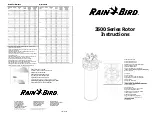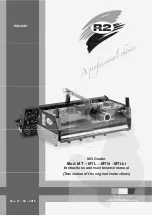
16
1.0 APPLICATIONS
1.1 PURPOSE:
Self-Retracting Devices (SRDs) are designed to be a component in a personal fall arrest system (PFAS). Figure
1 illustrates SRDs covered by this instruction manual. They may be used in most situations where a combination of worker
mobility and fall protection is required (i.e. inspection work, general construction, maintenance work, oil production,
confined space work, etc.).
1.2 STANDARDS:
Your SRD conforms to the national or regional standard(s) identified on the front cover of these
instructions. Refer to the local, state, and federal (OSHA) requirements governing occupational safety for additional
information regarding Personal Fall Protection.
1.3 TRAINING:
This equipment is intended to be used by persons trained in its correct application and use. It is the
responsibility of the user to assure they are familiar with these instructions and are trained in the correct care and use
of this equipment. Users must also be aware of the operating characteristics, application limits, and the consequences of
improper use.
1.4 LIMITATIONS:
Always consider the following limitations when installing or using this equipment:
• Capacity:
SRDs are for use by one person with a combined weight (clothing, tools, etc.) meeting the
Capacity Range
specified in Table 1 for your standard(s). Make sure all of the components in your system are rated to a capacity
appropriate to your application.
• Anchorage:
Anchorages selected for fall arrest systems shall have a strength capable of sustaining static loads
applied in the directions permitted by the system of at least:
1. 5,000 lbs. (22.2 kN) for non-certified anchorages, or
2. Two times the maximum arresting force for certified anchorages.
When more than one fall arrest system is attached to an anchorage, the strengths set forth in (1) and (2) above shall
be multiplied by the number of systems attached to the anchorage.
FROM OSHA 1926.502 AND 1910.140:
Anchorages used for attachment of personal fall arrest systems shall be
independent of any anchorage being used to support or suspend platforms, and capable of supporting at least 5,000 lbs.
per user attached, or be designed, installed, and used as part of a complete personal fall arrest systems which maintains
a safety factor of at least two, and is under the supervision of a qualified person.
• Locking Speed:
Situations which do not allow for an unobstructed fall path should be avoided. Working in confined
or cramped spaces may not allow the body to reach sufficient speed to cause the SRD to lock if a fall occurs. Working
on slowly shifting material, such as sand or grain,may not allow enough speed buildup to cause the SRD to lock. A
clear path is required to assure positive locking of the SRD.
• Free Fall:
Properly using an SRD in overhead applications will minimize free fall distance. To prevent an increased free fall
distance, follow the instructions below:
•
Never clamp, knot, or otherwise prevent the lifeline from retracting or staying taut.
•
Avoid any slack in the lifeline of the SRD.
•
Do not work above the level of your anchorage.
•
Do not lengthen SRDs by connecting a lanyard or similar component without consulting 3M.
For product-specific information relating to free fall and fall clearance values, please refer to Table 1 of this
instruction.
• Swing Falls:
Swing Falls occur when the anchorage point is not directly above the point where a fall occurs. The
force of striking an object in a swing fall may cause serious injury (see Figure 3A). Minimize swing falls by working as
directly below the anchorage point as possible (Figure 3B).
• Fall Clearance:
Figure 3B illustrates Fall Clearance Calculation. Fall Clearance (FC) is the sum of Free Fall (FF),
Deceleration Distance (DD) and a Safety Factor (SF): FC = FF +DD + SF. D-Ring Slide and Harness Stretch are
included in the Safety Factor. Fall Clearance values have been calculated and are charted in Figure 4. A Safety Factor
of 1.5 ft (0.45 m) was used for all values in Figure 4.
For falls from a standing position where the SRD is anchored directly overhead (Figure 3B), SRD Fall Arrest Systems
should have the minimum Fall Clearances specified in Table 1. Falls from a kneeling or crouching position will require
an additional 1 m (3 ft) of Fall Clearance. In a swing fall situation (Figure 3C), the total vertical fall distance will be
greater than if the user had fallen directly below the anchorage point and may require additional Fall Clearance.
Figure 4 and the accompanying table define the Maximum Work Radius (C) for various SRD Anchorage Heights (A)
and Fall Clearances (B). The Recommended Work Zone is limited to the area located within the Maximum Work
Radius.
• Hazards:
Use of this equipment in areas where surrounding hazards exist may require additional precautions to
reduce the possibility of injury to the user or damage to the equipment. Hazards may include, but are not limited
to: high heat, caustic chemicals, corrosive environments, high voltage power lines, explosive or toxic gases, moving
machinery, or overhead materials that may fall and contact the user or fall arrest system. Avoid working where your
lifeline may cross or tangle with that of another worker. Avoid working where an object may fall and strike the lifeline;
resulting in loss of balance or damage to the lifeline. Do not allow the lifeline to pass under arms or between legs.
• Sharp Edges:
Avoid working where the lifeline will be in contact with or abrade against unprotected sharp edges.
Where contact with a sharp edge is unavoidable, cover the edge with a protective material.
Summary of Contents for Nano-Lok 3100468
Page 2: ......
Page 3: ...3 2 B A D E F G C B A D E F G C B A D E F G C 3101685 3101685 ...
Page 5: ...5 5 6 A B C D 7 D A B C Step 1 Step 2 9 A B ...
Page 6: ...6 10 11 12 C C 13 14 15 16 C C 17 ...
Page 7: ...7 18 1 B A B A 2 C C D 3 E A C 4 F D D ...
Page 8: ...8 19 1 A B B A 2 D D C E 3 G H F 4 F A 5 F E I G E 6 D D C A D D K K C J ...
Page 9: ...9 20 1 A B 2 C D D 3 E G F 4 A E 5 E F 6 D C A ...
Page 10: ...10 21 E D A D G F F 22 23 A B C 24 ...









































